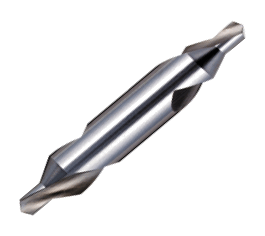Centre Drill: Difference between revisions
From DT Online
mNo edit summary |
m (Added Amazon Link) |
||
| (2 intermediate revisions by the same user not shown) | |||
| Line 1: | Line 1: | ||
<div class="floatright"><dtamazon type="search" search="Centre Drill"><img alt="CentreDrill.png" src="/images/a/a9/CentreDrill.png" width="300" height="267" /></a></dtamazon></div> | |||
__TOC__ | __TOC__ | ||
=====Description===== | =====Description===== | ||
Also known as '''Slocombe Drills''', [http://wiki.dtonline.org/index.php/File:CentreDrill.png '''Centre Drills'''] were originally designed to create the countersink required to locate a tailstock centre when turning between centres. They have a point angle of 60° to match the angle of a '''Tailstock Centre''' | |||
Also known as '''Slocombe Drills''', [http://wiki.dtonline.org/index.php/File:CentreDrill.png '''Centre Drills'''] were originally designed to create the countersink required to locate a tailstock centre when turning between centres. They have a point angle of 60° to match the angle of a '''[[Centre Lathe|Tailstock Centre]]''' | |||
=====Features and Uses===== | =====Features and Uses===== | ||
A [http://wiki.dtonline.org/index.php/File:CentreDrill.png '''Centre Drill'''] can also be used to provide a start location for a drill when drilling down the centre of a bar held in a '''[[Centre Lathe|Lathe]]''' '''chuck'''. '''Centre Drills''' are short and rigid enough to mark the bar centre without wandering off if they are carefully offered up to a rotating work-piece. Although their point angle does not match that a '''[[Twist Drills|Twist Drill]]''' only a small indentation is required, so for most work in '''[[Design and Technology]]''', this is not an issue. | A [http://wiki.dtonline.org/index.php/File:CentreDrill.png '''Centre Drill'''] can also be used to provide a start location for a drill when drilling down the centre of a bar held in a '''[[Centre Lathe|Lathe]]''' '''chuck'''. '''Centre Drills''' are short and rigid enough to mark the bar centre without wandering off if they are carefully offered up to a rotating work-piece. Although their point angle does not match that a '''[[Twist Drills|Twist Drill]]''' only a small indentation is required, so for most work in '''[[Design and Technology]]''', this is not an issue. | ||
---- | ---- | ||
<span style="color: green">'''Note:''' | <span style="color: green">'''Note:''' | ||
| Line 13: | Line 17: | ||
</span> | </span> | ||
---- | ---- | ||
{{Centre Drill Buyers Guide}} | {{Centre Drill Buyers Guide}} | ||
Latest revision as of 13:10, 7 November 2017
Description
Also known as Slocombe Drills, Centre Drills were originally designed to create the countersink required to locate a tailstock centre when turning between centres. They have a point angle of 60° to match the angle of a Tailstock Centre
Features and Uses
A Centre Drill can also be used to provide a start location for a drill when drilling down the centre of a bar held in a Lathe chuck. Centre Drills are short and rigid enough to mark the bar centre without wandering off if they are carefully offered up to a rotating work-piece. Although their point angle does not match that a Twist Drill only a small indentation is required, so for most work in Design and Technology, this is not an issue.
Note: Engineers may prefer a Spot Drill which is a short stubby drill designed specifically for this purpose. Alternatively, a small indentation can be cut in the bar centre with a sharp lathe tool.
Centre Drills (aka Slocombe Drills) were designed to provide a location for a Tailstock Centre (hence their 60deg point angle) but are commonly used to make a small starting indentation to guide further drilling in a Lathe.
- If used only to start a drilled hole then one or two of the mid-range sizes will suffice since it is only the tip of the Centre Drill that will be used.
- Choose only those made from good quality High Speed Steel and offer them carefully up to the workpiece whilst it is rotating since the smaller sizes in particular, can break easily.
 |
| Slocombe Centre Drill |
